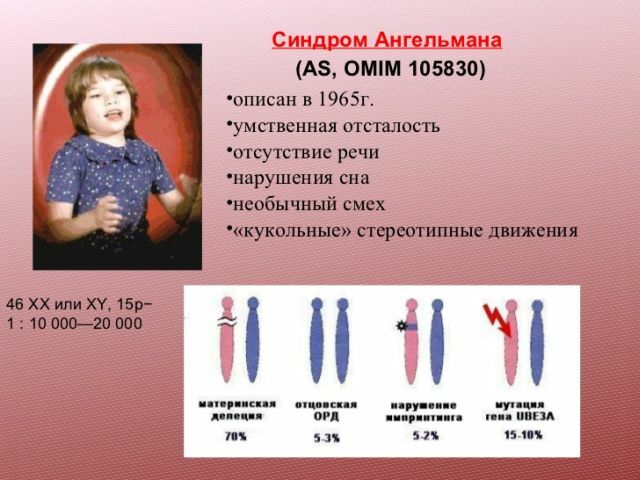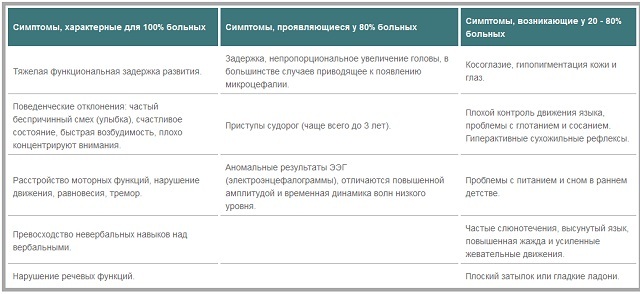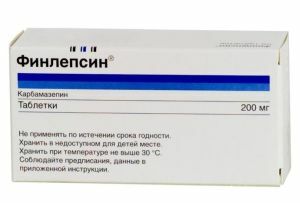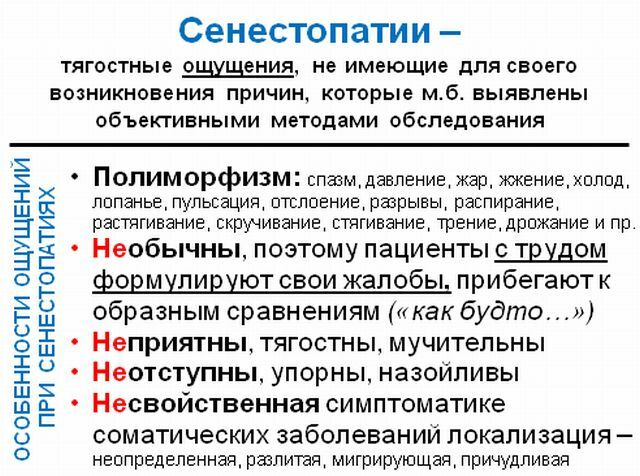 Angelmann syndrome( "happy puppet" syndrome, "parsley syndrome") is a fairly rare neurogenetic disease associated with chromosomal abnormalities.
Angelmann syndrome( "happy puppet" syndrome, "parsley syndrome") is a fairly rare neurogenetic disease associated with chromosomal abnormalities.
Approximately one thousand newborns have one child with this pathology. In patients, there is a physical and intellectual delay in development, sleep disorders, seizures, violent movements, and private, causeless laughter.
Children with this pathology always look very happy.
Contents
- History of the disease
- Pathogenesis and causes
- Genetic mutations increase the risk of disease
- Symptom groups
- Clinical picture in detail
- Diagnosis and early detection
- Photo and video materials on the topic
- Improvement of the condition and life of patients
- Features of upbringing and adaptation
Historystudying the disease
The disease bears the name of Harry Angelman, a British pediatrician, who first differentiated this syndrome in 1965. Togdand he received the name of the syndrome of a happy puppet, but today this term is not used, since it was considered disparaging.
Dr. Angelman was involved in the treatment of several children with similar symptoms and suggested a general diagnosis. To prove the diagnosis and get accurate data at that time was not possible, due to the lack of technologies that are available today. His theories the doctor reflected in an article called "Children puppets."
At that time the publication did not arouse much public interest, and was soon forgotten. Once again, it was remembered in the eighties, when the necessary research methods appeared. Scientists found that most of the children with the syndrome do not have a small part of the 15 chromosomes.

Pathogenesis and causes of
This defect arises from the deletion( loss of genetic material) of segment 15 of the chromosome. Other causes are often called single-father dysomia( the inheritance of two paternal copies of the chromosome, instead of copies from both parents), the translocation or mutation of one gene.
Also, the syndrome can appear as a result of the mutation of the gene involved in the metabolism of ubiquitin.
The majority of patients with this pathology in the family history do not have genetic abnormalities. However, for a certain percentage of patients, this syndrome is inherited. Risks are higher if the parents have chromosomal abnormalities. An interesting fact is that if a child with this syndrome is born in a family, the probability of having another child with the same pathology is 1%.
The appearance of Angelman's syndrome is quite spontaneous, and in virtually every family a child with this disease can be born. There is no specific statistical data on the number of children with this syndrome.
According to various estimates, the number of newborns with the syndrome of the doll varies from one to ten thousand to one to twenty thousand. Scientists suggest that in fact this number is much larger.
Genetic mutations increase the risk of
The appearance of Angelman's syndrome is associated with the presence of various chromosomal abnormalities in the parents of a future child. Among such deviations are usually called:
- trisomy of chromosomes - presence of one or more superfluous chromosomes in a chromosome set;
- inversion of - reversal of one of the chromosome segments by 180 degrees, while a part of the chromosome is missed, and genes are arranged in the opposite order;
- microdeletion of , which is the result of Y chromosome rearrangement and exchange of sites between chromosomes, a small amount of chromosomes is observed, and one of the genes may also be absent;
- deletion of - lack of one of the chromosome sections;
- translocation of - transfer or attachment of a region of one chromosome to another chromosome;
- duplication of - copying part of the chromosomes, resulting in excess genetic material;
- ring chromosome - there is no genetic material at the ends of the chromosome, while the newly formed ends are connected in the form of a ring.

Gene mutations that can cause the development of
syndrome Symptoms of
Usually the diagnosis of Anghelman's syndrome is put at the age of 3 to 7 years, when symptoms become pronounced. A newborn child with a syndrome does not differ from a healthy child, but during the first months of life there are problems with feeding, children are slowly gaining weight, there are problems with sleep, a lag in the development of motor skills.
All symptoms of parsley syndrome are divided into several types. They have a relationship with the patient's neuralgic, mental and physical state:
- The physical symptoms of include vision problems( strabismus, optic nerve atrophy), tongue poking, wide mouth,
 large distance between teeth, head size proportionally smaller relative to other body parts, albinism and hypopigmentation, inflexion of the joints of the feet when walking( hence the comparison with puppets), scoliosis.
large distance between teeth, head size proportionally smaller relative to other body parts, albinism and hypopigmentation, inflexion of the joints of the feet when walking( hence the comparison with puppets), scoliosis. - Among the neurological symptoms of , trembling in the limbs, a number of sleep disorders, hysterical seizures, the intensity of which is great at the age of three, is observed gradually decreasing as we grow up, problems in communication( delayed speech development), hyperactivity and attention deficit.
- Psychological symptoms of are usually expressed in excessively emotional behavior( constant happy appearance, friendliness), mental retardation in severe form.
Clinical picture in detail
Different patients may exhibit different symptoms. This difference depends on the degree and type of chromosomal abnormality.
It is possible to separate the signs by the frequency of their manifestation in children with Angelmann syndrome:
- Symptoms that are manifested in all patients .They include a severe functional developmental delay, deviations in behavior( laughter and smile, having no cause, a state of happiness, increased excitability, reduced concentration of attention).Also, in absolutely all patients there is a violation of motor functions, imbalance, tremor, the predominance of non-verbal skills over verbal, speech disorders.
- Symptoms typical for 80% of patients. Delay in growth, leading to a disproportion of the head relative to other parts of the body. Often this leads to the development of microcephaly. In children under three years of age, epileptic seizures often appear, then they become less frequent or disappear altogether. The results of the electroencephalogram are often anomalous, low-level waves have an increased amplitude and temporal dynamics.
- Symptoms that occur in less than 80% of patients. Such manifestations include strabismus, a decreased ability to control the movements of the tongue, problems with swallowing, hypopigmentation of the eyes and skin, albinism. Many patients exhibit increased activity of tendon reflexes. In early childhood, many have problems with nutrition and sleep. Among the manifestations also can be called salivation, poking out of the tongue, constant thirst. External features include the presence of a flat nape and smooth palms.
As you grow up, the manifestations of the syndrome change. Sleep disorders, hyperactivity, convulsive syndrome are less common. Adults who have Angelmann syndrome look younger than their peers.
Puberty occurs a little later than in individuals who do not have this pathology. Patients may have their own children, but there is a high risk of transmitting the disease to the offspring.
Many adult patients suffer from uncontrolled urination. Often there are difficulties with motor skills, which leads to the need to wear clothes without lightning, buttons. Among adults, there is a problem of excess weight, so you need to monitor the adherence to a special diet.
Children well perceive oral speech, and understand the content of almost all conversations, but rarely respond. Often they refuse to take part in the conversation, and use a few dozen words in the speech.

Diagnosis and timely detection of
The doll syndrome can be diagnosed before the child is born, by conducting a genetic study of the fifteenth chromosome.
Diagnosis can be invasive and non-invasive. The invasive method of research exists in medicine quite a long time, but it is rather risky, since it is necessary to penetrate into the uterus and withdraw the amniotic fluid.
A non-invasive method involves a mother's blood test, in which the baby's DNA is analyzed. Based on this study, conclusions are drawn about the presence or absence of certain abnormalities.
Diagnosis is also performed in newborns who have muscle tone disorders, lag in the development of speech and motor skills.
It is necessary to follow the expression of the infant's face, his behavior, the manifestation of emotions, movements. If the infant has difficulties with flexing the limbs, there is tremor, chaotic and sharp movements of the limbs, then it is worthwhile to seek the advice and assistance of specialists.
Often the diagnosis of Anghelman's syndrome is placed at the age of 3 to 7 years, when you can notice a clear manifestation of the signs of the disease. Depending on the degree of damage to the 15 chromosomes, manifestations can have a different severity: some patients have difficulty even in speech, while others can lead an independent life.
Photo and video materials on
Video, as well as a gallery with photos of children and adults diagnosed with Angelmann's Syndrome:
Improvement of the condition and life of
patients Angelman syndrome is a genetic disease for todayday there are no methods of restoring chromosomal abnormalities, and treatment is impossible. However, there are a large number of ways to reduce symptoms, which facilitates the condition of such people.
In each case, the rehabilitation program is developed individually, according to the symptoms and condition of the individual patient. Specialists identify four main areas of therapy:
- Admission antiepileptic drugs and anticonvulsants .These drugs help control and reduce the
 frequency of seizures caused by the disease.
frequency of seizures caused by the disease. - Therapeutic physical training - helps to develop fine motor skills and solve other problems of the motor apparatus. Children with chromosomal abnormalities develop slower than their healthy peers, and this requires patience on the part of the family.
- Sign Language .Patients with the puppet syndrome speak little, but quite successfully use sign language. Training should start from a very early age.
- Behavioral therapy .This program allows you to give a correct and effective upbringing to children who have abnormalities, will help cope with hyperactivity and attention deficit.
Many doctors note the similarity between children with autism and Angelman syndrome. American scientists have made progress in the treatment, namely the use of intravenous injections with the hormone Secretin. The positive effect is expressed in reducing the signs of undesirable behavior, as well as improving communicative skills.
Features of education and adaptation
As the child grows up with this pathology, the symptoms change, become less intense, or, on the contrary, more intense, old ones may disappear and new ones may appear. Prospects in the patient's condition largely depend on the conditions that surround the patient.
A benevolent environment, the atmosphere of affection affection affords the patient the chance to become, at least partially, an independent person. With proper care, signs of the disease become easier with time. Life expectancy in people with Anghelman syndrome is average. It is necessary to remember about regular examinations, proper nutrition, as well as observance of the conditions of therapy.
Teaching a child in school requires the use of inclusive programs. However, in Russia and the CIS countries today these programs are not included in a wide practice. Such children need a special approach, which includes training in the concentration of attention. An important requirement is also the possibility of the educational institution to provide medical assistance in case of a fit.
In our society at the moment, people with chromosomal abnormalities are cautious and cautious. In recent years, various activities have been actively carried out aimed at spreading knowledge about such diseases, as well as creating tolerance in society.








